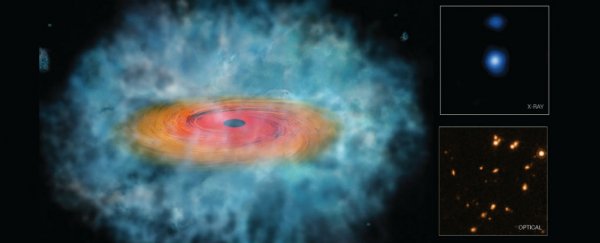If you're looking for one of the biggest objects in the Universe, supermassive black holes are right up there. We're talking about an object of up to 17 BILLION solar masses concentrated at the core of a galaxy that's only about the size of our Solar System. Incredible.
One of the biggest mysteries about supermassive black holes is actually pretty simple: how on Earth did they get so big?
For years, astronomers have debated over two scenarios - they either started out really huge in the first place, or they started out small, but grew at unfathomable speeds that would break our current understanding of the laws of physics. Now, thanks to new clues from NASA's Hubble space telescope, we might finally have an answer.
Black hole 'seeds' of around 100,000 times the mass of the Sun have been spotted, and these colossal objects could be what kickstarted the process for black holes to grow supermassive.
"There is a lot of controversy over which path these black holes take," said one of the team, Andrea Ferrara from the Scuola Normale Superiore in Italy. "Our work suggests we are converging on one answer, where black holes start big and grow at the normal rate, rather than starting small and growing at a very fast rate."
What makes the 'started big and got bigger' hypothesis tricky to reconcile is the fact that physicists have struggled to find a seed candidate that's big enough to kickstart a supermassive black hole, without running into the 'impossible rate of growth problem' that the 'started small and got massive' hypothesis has.
It would make sense that supermassive black hole seeds grow from merges between smaller black holes of up tp 100 solar masses, scientists have suggested, and these seeds would grow larger and larger by pulling in gas from their surroundings. Once they get to a certain size, they'd start collapsing in on themselves to form an even larger black hole.
But no one's been able to explain how these smaller black holes could merge and grow fast enough to reach billions of solar masses in time for the first appearances of supermassive black holes in our Universe - less than 1 billion years after the Big Bang.
Instead, scientists have put forward another possibility - what if supermassive black holes formed directly from clouds of gas, which could allow them to start big and keep getting bigger?
To test this hypothesis, Ferrara and her colleagues used the Hubble, Chandra, and Spitzer space telescopes to search for black hole seed candidates.
Their search turned up two separate records of what appear to be black hole seeds - objects with 100,000 times the mass of the Sun, which formed directly from a massive cloud of gas collapsing in on itself.
Computer models revealed that if a supermassive black hole were to form from these gas clouds, it would effectively 'skip' the earliest steps of growth, which could explain how these cosmic behemoths managed to achieve such an incredible mass just 1 billion years after the Big Bang.
"Black hole seeds are extremely hard to find and confirming their detection is very difficult. However, we think our research has uncovered the two best candidates so far," says Andrea Grazian from Italty's National Institute for Astrophysics.
Without more of these seed candidates to study and extract more clues from, it's too early to say for sure that these gas clouds were the birthplace of some of the biggest objects in our Universe. But this is as close as we've ever gotten to explaining just how they came to be, and that's pretty damn exciting.
The team plans to carry out follow-up observations in X-rays and in infrared wavelengths to check if these two seed candidates have more properties expected for black hole seeds. "Our discovery, if confirmed, would explain how these monster black holes were born," says Fabio Pacucci from Scuola Normale Superiore.
The study has been accepted for publication in an upcoming edition of Monthly Notices of the Royal Astronomical Society, but you can access it freely now at arXiv.org.
